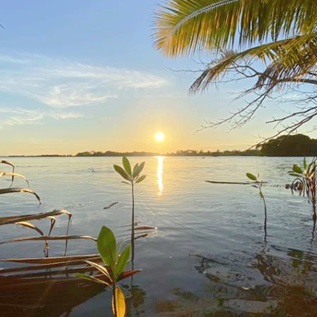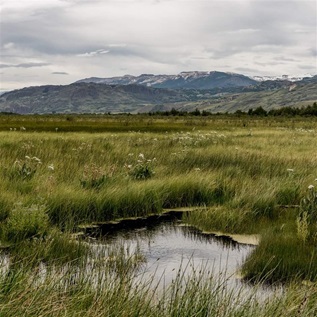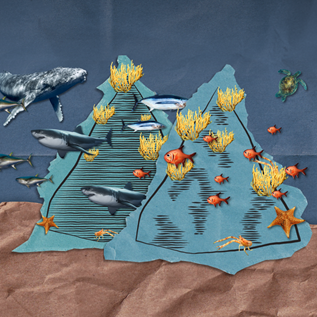Decade-Long Fishing Closure Aims to Restore African Penguin Population
Pew marine fellow says additional conservation efforts may be necessary to save the species

With only about 10,000 breeding pairs left, the endangered African penguin is at risk of extinction by 2035. The loss of this species—a vital part of the marine ecosystem and South Africa’s ecotourism sector—could have significant ecological and cultural impacts.
The penguins’ declining population is due in part to decreases in their main food source: anchovies and sardines. Richard Sherley, a marine ecologist, conservation biologist, and 2019 Pew marine fellow, has studied how efforts to rebuild these forage fish stocks could help save penguin colonies in South Africa.
To determine whether limiting the fishing of these forage fish would slow the decline of the penguin population in the region, South African officials worked with researchers—including Sherley—to conduct a multiyear experiment that closed the waters to commercial fishing around some islands for staggered three-year periods. The resulting data showed that eliminating fishing near the penguins’ breeding colonies led to improvement in population trends—meaning either growth or slowing declines—by about 1% per year. And this prompted the South African government to announce a decade-long closure of commercial fishing in the waters around the penguin colonies, starting in January of this year, with a review six years after implementation.
This interview with Dr. Sherley has been edited for clarity and length.
Q: Why did you first begin to study the relationship between forage fish extraction and population changes in the endangered African penguin?
A: I’ve been working with penguins since 2007, and while I didn’t start out working on interactions with fisheries, it became obvious that the major issue was them losing their prey base through a combination of climate change and fishing. So, in 2008, we began to try to understand what portion of that was due to fishing.
Q: And what did you learn about this prey base?
A: The two species that seem to be an essential food source for seabirds are sardines and anchovies. However, these are also species that have historically been fished in the region. The sardine is fished for direct human consumption and is an important and affordable food resource in South Africa—and a traditional food, particularly up on the west coast of South Africa. On the other hand, anchovies are fished almost exclusively for fish meal, which is predominantly exported to feed livestock and for fish farming.
The difficulty is that these two fisheries operate slightly differently. The exploitation rates—meaning the percentage of the overall fish stock that’s removed by fishing—are quite low in the anchovy fishery. But the sardine fishery in South Africa has, at least in the last 10 to 15 years, had very high exploitation rates, even by international standards.
Q: What’s the potential consequence of a fishery with a high exploitation rate?
A: The fishery is at greater risk of becoming unsustainable.
Q: So wouldn’t it be good news for the penguins that the anchovy fishery, at least, seems less at risk than the sardine fishery?
A: Unfortunately, the adult sardine is particularly important to penguins when they’re building up their body condition during the summer before and after they breed—and before and after they molt. Therefore, there’s been a need to manage the sardine fisheries more effectively since they seem to play a role in the penguins’ diet that anchovies can’t replace.
Q: How did you go about studying the impact of fishing on the penguin population?
A: A group of us did a 15-year experiment, starting in 2008 and based on a 20-kilometer (12.4-mile) closure area, and the outcome from that experiment seemed to be that the impact of not fishing is worth about a 1% to 1.5% increase per year in the population growth rate for the penguins.
During the experiment, we mostly measured the parts of the penguin life cycle that revolve around breeding, such as breeding success and foraging of breeding birds and chick condition, but we couldn’t measure whether the closure would have impacts on longer-term adult survival.
Q: What do you hope will be the result of the fishing ban throughout the next 10 years?
A: I hope we can get to the six-year review and document whether the closures have been useful. I don’t think the closures will be enough on their own to reverse the decline—the population is going down between 5% and 10%, depending on the location, so the experiment’s results suggest you can only offset about one-fifth of that decline with long-term closures—but I’d be really pleased to be wrong.
Q: It sounds like you remain concerned about the species’ long-term prospects.
A: It’s hard to know how long it might take to see the impact of the fishing ban, but if the situation persists as it is, with the low abundance of sardines off the west coast, it will be difficult for the penguin population to recover. We’ve put a lot of effort in, and we think our research has demonstrated the connection between fishing and the penguins’ population decline quite well, but the wheels turn slowly. The time it’s taken just to get to the point of instituting this fishing ban has been frustrating because, in the meantime, the penguins have continued to decline. We’re essentially watching them disappear.
Q: So what’s the solution?
A: We either need a recovery of sardine stocks, which may not be possible in current climate change circumstances, or we need to get creative about how we can develop new places for penguins to breed.
Q: What could some of those creative approaches look like?
A: There are lots of projects going on to improve breeding habitats. For example, there are groups working to improve the design of artificial nest boxes to increase breeding success, efforts to establish new colonies, and rehabilitation efforts to help chicks that have been abandoned and adults that have been injured, among other projects. There’s a lot going on in this space, but in the absence of being able to recover the sardine stocks, it’s difficult to know if it will make a difference. Without food, there can be no penguins.











